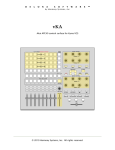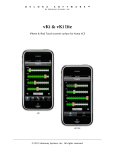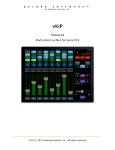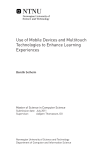Download PacaConnect
Transcript
D E L O R A S O F T W A R E ™ b y Ha rmo ny S yste ms, I nc . PacaConnect Version 1.0 A virtual Midi interface, merger, patchbay and “proxy server” for Symbolic Sound’s Paca and Pacarana sound engines Cop y right 2010 b y Harmony Sy stems, Inc. © 2010 Harmony Systems, Inc. All rights reserved. Under the copyright laws, this manual may not be copied, in whole or part, without the written consent of Harmony Systems, Inc. Your rights to the software are governed by the accompanying software license agreement. Delora Software, PacaConnect, PacaMidi, vM2, vKi, vKi lite and vKiP are trademarks of Harmony Systems, Inc. Other company and product names mentioned in this manual are trademarks of their respective companies. Mention of third-party products is for informational purposes only. Harmony Systems assumes no responsibility with regard to the performance or use of these products. Every effort has been made to ensure the accuracy of this manual. Please contact Delora Product Support ([email protected]) should you have questions regarding information in this manual. 2 D e l ora S oftwa re ™ b y Har mony Sy s t e ms , I nc. - P acaConne ct Table of Contents Introduction to PacaConnect! 1 The PacaConnect Advantage The Need for PacaConnect (or PacaMidi) - in Depth The PacaConnect Way 1 2 3 PacaConnect In Summary How It Works 5 5 PacaConnect: Sample Configurations! 9 Set-Up #1: Live/On-Stage with a MacBook or MacBook Pro Set-Up #2: Simple Studio with any Mac with a built-in Airport Set-Up #3: Studio with any Mac with a built-in Airport 9 10 11 Set-Up #4: Studio WiFi, any Mac with a built-in Airport Set-Up #5: Mac Pro Studio, dedicated wireless OSC network Set-Up #6: Mac Pro Studio, dedicated Paca(rana) network 12 13 14 Requirements! 15 About Your License! 16 Installation! 17 Updates or Cross Grade from PacaMidi! 18 Set-Up! 19 Run the PacaConnect Preference Pane Enter Your License Key 19 20 Set-up PacaConnect Run PacaConnect 21 26 Using PacaConnect! 27 Removing PacaConnect! 28 Troubleshooting! 30 Appendix A: Setting Up An Ad-Hoc WiFi Network! 31 Acknowledgements! 35 D e l ora S oftwa re ™ b y Har mony Sy s t e ms , I nc. - P acaConne ct Introduction to PacaConnect Delora Software’s PacaMidi offers an economical, convenient way to combine a Symbolic Sound Paca or Pacarana sound engine with one or two MIDI devices. It saves the expense of a Paca(rana) MIDI interface, numerous MIDI cables, and even a hardware MIDI merger. Its use dramatically simplifies a Kyma workstation setup and is especially attractive for portable or performance configurations. PacaConnect continues with this tradition by adding a significant enhancement: it has a "Pacarana Proxy" that connects a Paca or Pacarana on one network to "clients" connected to a second network. PacaConnect does this in such a manner that any application that follows the Pacarana's OSC conventions can have full bidirectional control of the Paca(rana). This includes Delora's vKi, vKi lite, vKiP, and other third party applications like TouchOsc. PacaConnect achieves all of this with minimal user configuration and interaction. PacaConnect also provides the same features as PacaMidi, including its “virtual MIDI interface and patchbay". It provides three merged MIDI inputs to your Paca(rana), and a MIDI output from your Paca(rana). PacaConnect can be used to connect up to two physical MIDI devices like synthesizers or MIDI controllers to the Paca(rana), as well as one or more sequencers or other music software at the same time. The PacaConnect Advantage The combination of the Pacarana proxy and the "virtual MIDI patchbay" affords new possibilities for reducing overall system complexity, whether on stage or in the studio. For example a viable Kyma performance set up can now be assembled with a Mac Book or Mac Book Pro, a Paca(rana), a FireWire cable, a soundcard, and a simple RG45 network cable. No other external boxes, such as MIDI interfaces, Ethernet routers or switches, or WiFi access points are needed. Furthermore by using a USB keyboard or other controllers, full MIDI performance control over a Kyma sound can be achieved without additional MIDI cables or MIDI components. Full wireless remote control of the Kyma VCS can be achieved by adding an application like vKi running on the iPhone/ iPod Touch or vKiP running on an iPad. PacaConnect's system streamlining features are not just for live performance. Studio set ups can also benefit by removing unnecessary external devices like MIDI mergers, a 1 D e l ora S oftwa re ™ b y Har mony Sy s t e ms , I nc. - P acaConne ct USB MIDI interface connected to the Paca(rana), and potentially WiFi access points and other networking hardware and cables. iMacs, MacMinis, and some Mac Pro models include built-in WiFi connectivity. You can set up special "computer-to-computer" WiFi networks (also called "Adhoc WiFi networks") with these Macs to provide a dedicated Wireless network for interacting with Kyma using OSC. This type of dedicated network affords enhanced reliability as well as reduced control latency, features not only essential for live performance but also of great benefit in the studio. We will show how PacaConnect can be beneficially integrated into specific studio or live configurations in the next chapter “PacaConnect: Sample Set-Ups”. The Need for PacaConnect (or PacaMidi) - in Depth The Paca(rana) does not have a built-in MIDI interface. Without PacaConnect, you must attach a USB MIDI interface, control surface, or other MIDI controller directly to the Paca(rana)'s host USB connection, or employ a MIDI interface included as part of the Paca(rana)’s external soundcard. This works well but suffers a few limitations. Let’s look at each and see how PacaConnect provides an elegant, affordable solution to each. Limitation #1: Only one device at a time The Paca(rana) can select only a single USB or FireWire MIDI port at any time. This restricts you to only a single MIDI device without the addition of some type of MIDI merger facility. So a Kyma performance set-up that requires an external MIDI keyboard and a control surface like the MotorMix or BCF2000 would require a hardware MIDI merger device, or a software application running on your computer, to combine the outputs from the keyboard controller and control surface. If your Kyma usage includes some type of sequencing application the challenge becomes even greater to accommodate all the input sources, including MIDI from the sequencer. Limitation #2: One for the Paca(rana), one for the computer A very common set up is to have a sequencer or other music program running on a computer and sending MIDI to and from the Paca(rana). This requires that the Paca(rana) have its MIDI interface, and that the computer have a spare MIDI input and output to connect to it. If the computer lacks a MIDI interface, or its existing ones are already in use, then an additional MIDI interface must be added. So in this common use situation you will need to add two USB MIDI interfaces; one for the Paca(rana) and one for the computer. 2 D e l ora S oftwa re ™ b y Har mony Sy s t e ms , I nc. - P acaConne ct Limitation #3: Cable cost, clutter, complexity Establishing a MIDI connection between your computer and the Paca(rana) requires a total of four cables best case: two MIDI cables and two USB/FireWire cables. Cables cost money, are potentially untidy, and have a remarkable knack for developing intermittent issues at the wrong time. This may be understating the problem. Some inexpensive USB MIDI interfaces replace the normal MIDI connector with a built-in cable that plugs directly into the synthesizer or other device. This makes sense until you want to use one of these interfaces for both the computer and Paca(rana). To do this you need a special cable adaptor for each connection. More cost, clutter, and another point of potential failure. One of the Paca(rana)’s most exciting features is its Open Source Control (OSC) implementation. OSC messages are sent to and from the Paca(rana) over a standard local area network that the Paca(rana) is connected to via its Ethernet connection. This works very well and is nearly configureless because of the Paca(rana)’s various networking features, including Bonjour support. A common, desirable way to connect the Paca(rana) and control it using a wireless device such as an iPhone or iPad, is to connect the Paca(rana) directly to a computer’s Ethernet port and then have the wireless device connect to the computer’s built-in WiFi port. This provides a clean, minimal hardware and complexity set up that is ideal for on-stage, or in the studio use. But there is a problem: connecting the devices in this manner creates two independent networks that cannot fully communicate with one another. Without a bridge or proxy application working with both networks, reliable bidirectional OSC control is not possible. The PacaConnect Way PacaConnect solves the two network communication problem described above by creates a “Pacarana Proxy” so that these two separate networking worlds are united for OSC messages to and from the Paca(rana). PacaConnect also takes a new approach to the MIDI challenges and limitations described in the previous section that leverages the "MIDI-over-OSC" feature now built into every Paca(rana). MIDI-over-OSC is a standard way to send MIDI between two networked devices using the powerful Open Sound Control (OSC) standard. This means that every device connected to the same network can exchange MIDI information with no additional MIDI interfaces or cables! 3 D e l ora S oftwa re ™ b y Har mony Sy s t e ms , I nc. - P acaConne ct The Paca(rana), like your computer, includes a standard network cable connection that can connect to your existing network. This inexpensive cable and PacaConnect can now replace all of the MIDI interfaces, mergers, and cables previously mentioned. PacaConnect also runs the aforementioned “Pacarana Proxy” so that all network OSC traffic intended for the Paca(rana) (or from the Paca(rana)) arrives as originally intended. PacaConnect is a small OSX software application, called a "user agent", that silently runs in the background. It always searches for an available Paca or Pacarana on any open networking port. When one is located, PacaConnect establishes a "network MIDI connection" with the Paca(rana) using MIDI-over-OSC. PacaConnect uses this connection to send and receive MIDI to and from the Paca(rana). What makes this connection so useful is that PacaConnect itself acts like a multi-port MIDI interface with a built-in merging facility. PacaConnect provides two device "slots" that can be set to any MIDI device connected to your computer. So if you have an external synthesizer that you like to use as a keyboard controller, and a VCS-compatible control surface device like a MotorMix or BCF2000, PacaConnect merges their MIDI data and sends it on to the Paca(rana), just as if you had a physical two port MIDI interface with merging connected to the Paca(rana). Likewise when the Paca(rana) sends MIDI it is routed to both external devices. PacaConnect also starts the “Pacarana Proxy” and uses Bonjour to advertise Pacarana OSC services with the name <PACARANA_NAME>*, where the item in the brackets is replaced by the actual Paca(rana) name. For example if PacaConnect finds a Paca(rana) named "beslime-333" it will advertise the name "beslime-333*" as an available Paca(rana) using Bonjour. Applications like vKiP running on an iPad connected wirelessly to the Mac, but on a different network than the Paca(rana), will see the proxy as just another Paca(rana). Once the device connects to the proxy it can send and receive Pacarana OSC message as if it were directly connected to the Paca(rana). PacaConnect does even more. It creates an OSX "virtual MIDI port" that any application can use to send and receive MIDI to and from the Paca(rana). This virtual MIDI port is available simultaneously to any interested application. So if you have one (or more) music applications you need to use at the same time to send MIDI to the Paca(rana), PacaConnect handles it for you. PacaConnect is built for ease of set up and use. In fact after you take a few minutes to install and adjust a few settings PacaConnect can do its work automatically for you without further attention. You can even set it to run every time you log into your Mac. 4 D e l ora S oftwa re ™ b y Har mony Sy s t e ms , I nc. - P acaConne ct PacaConnect In Summary • Native OSX user agent program that is compatible with Intel and G5 Macs running Leopard. • Provides full bidirectional OSC control of Paca or Pacarana running on a different network than the OSC control client. • Dramatically reduces on-stage Mac Book or Mac Book Pro setup complexity by eliminating the need to have some type of WiFi router/switch/hub, as well as various MIDI paraphernalia. • Makes it straight forward (without extra components with any Airport enabled Mac) to establish an optimal dedicated wireless OSC control network with improved robustness and reduced latency. • Adds up to two always available MIDI control inputs and outputs to the Paca(rana), plus a "virtual MIDI port" for software applications. • Saves the expense of a USB MIDI interface, MIDI cables, and reduces network hardware requirements. • Compatible with wireless OSC applications running on the iPhone, iPod Touch, and iPad like vKi, vKiP, and TouchOsc. • MIDI connectivity fully supports external MotorMix or BCF2000 VCS controllers, as well as other MIDI "knob boxes" that can be used with the VCS's "MIDI Learn" feature. • "Set up once and forget about it" ease-of-use. How It Works This diagram on the next page illustrates what PacaConnect provides, and how it interacts with your MIDI devices, applications, and Paca(rana). 5 D e l ora S oftwa re ™ b y Har mony Sy s t e ms , I nc. - P acaConne ct PacaConnect is a "native" OSX application that works silently in the background. Technically it is a "user agent" program, a special type of OSX application that is ideally suited for this kind of task. User agents like PacaConnect do not require (nor offer) any direct user interface. Their operation is fully under OSX's direction. PacaConnect can automatically start when you log into your OSX account. If OSX detects any type of problem it can automatically restart PacaConnect. If you need to manually control PacaConnect's operation, or adjust its few settings, it has a control panel available through OSX's System Preferences, just like you control your mouse, keyboard, and other OSX components. All of this makes PacaConnect seem more like a Paca(rana) add-on and less a piece of software you run on your computer. A brief comment about PacaConnect being "native" - PacaConnect was created using OSX's standard developer tools and languages. It does not require a special "run time" 6 D e l ora S oftwa re ™ b y Har mony Sy s t e ms , I nc. - P acaConne ct or other unique components for it to operate. This insures smoother operation, less processing and memory demands, and better overall compatibility with OSX. Since PacaConnect was created with the same tools Apple uses for its applications you can expect a smoother transition when OSX, or your Mac, changes in the future. PacaConnect uses Symbolic Sound's "MIDI over OSC" feature supported in Paca(rana) based Kyma setups. This lets PacaConnect replace two MIDI interfaces and at least two MIDI cables with a single network cable that you may already be using! This saves the expense of as many as two MIDI interfaces, as well as the cables. The PacaConnect user agent has five major sections: 1. PacaProxy Server that connects a Paca or Pacarana on one network to "clients" connected to a second network. 2. CoreMidi-based interface to connect up to two external MIDI devices. 3. CoreMidi-based virtual MIDI port used by sequencers and other applications. 4. "MIDI-over-OSC" component to handle MIDI communications with the Paca(rana). 5. "Virtual MIDI patchbay" that connects all of the MIDI devices and ports with the Paca(rana). The MIDI patchbay is in some ways the heart of PacaConnect (& PacaMidi). It receives MIDI from the external devices, and any application, and merges those MIDI streams together in such a way that every device's MIDI activity reliably reaches the Paca(rana). So, for example, your external keyboard and your sequencer could both play the same sound at the same time. Another typical use is to have a VCS control surface like the MotorMix and your keyboard both controlling a Kyma sound. If you tried to do this with a hardware-only MIDI scheme you would not only need the required MIDI interfaces but in the case of having both a keyboard and MotorMix operating you would need the MIDI interface to have two ports and provide MIDI merging. This is normally accomplished with a USB interface on the Paca(rana) and an extra hardware device called a "MIDI merger". The patchbay also delivers MIDI from the Paca(rana) to any connected device or application. Note in the diagram that there are two network interfaces shown provided by the Mac. The one on the left is used for connections to various potential Pacarana OSC clients. The second network interface at the bottom is shown connected to the Paca(rana). PacaConnect's "PacaProxy Server" handles all of the various details that make it possible 7 D e l ora S oftwa re ™ b y Har mony Sy s t e ms , I nc. - P acaConne ct for a client on the first network to connect with the Paca(rana) with full bidirectional OSC control. (Note: This PacaProxy Server is the key component that differentiates PacaConnect from PacaMidi). One aspect of the Paca(rana) that needs to be heeded is that it only provides a single MIDI input and output. Thus all of your devices and applications share the same up to sixteen MIDI channels in both directions. All Kyma sounds share these same sixteen channels. The implication is that your sequencer, and external devices, can at most have sixteen independent MIDI "tracks" at one time. So if you choose to use two different applications at once keep in mind that you only have sixteen channels to work with. One final note regards Kyma VCS control surface support. Kyma currently uses MIDI channel 1 for all VCS control surface communications when Kyma is set up in “MotorMix” mode. MIDI Control Change numbers (CCs) sent on channel 1 are reserved for VCS use and will not reach a Kyma sound, nor be made available for such things as the VCS’s “MIDI Learn” feature. If you plan to send or receive these types of MIDI messages to your Kyma sounds, or use VCS “MIDI Learn” you need to set your controller to send on a channel other than 1. 8 D e l ora S oftwa re ™ b y Har mony Sy s t e ms , I nc. - P acaConne ct PacaConnect: Sample Configurations In the previous chapter, we touched on the role of PacaConnect in several setup scenarios. Here we will show the power of PacaConnect by integrating it into a variety of studio oriented or live configurations. If you need advice on how to set up an “adhoc” WiFi network that is assumed in some of the following configurations, go to Appendix A: Setting Up an Ad-Hoc WiFi Network. Set-Up #1: Live/On-Stage with a MacBook or MacBook Pro 9 D e l ora S oftwa re ™ b y Har mony Sy s t e ms , I nc. - P acaConne ct This is a typical stage set up built around a Mac laptop. The laptop's built-in Ethernet port connects directly to the Paca(rana) with a simple RG45 networking cable (for simplicity the FireWire connection between the laptop, Paca(rana), and soundcard is omitted from the diagram). The Mac’s Airport is set up via OSX's Networking Preference Pane to provide a "computer-to-computer" wireless network. iPhones, iPod touches, and iPads (as well as other WiFi devices) can connect to this network. Once connected they will "see" the Paca(rana) advertised using Bonjour by the PacaProxy Server. Once connected to the proxy the devices can send and receive OSC messages from the Paca(rana) just as if they were directly connected. Since the WiFi network is dedicated for the OSC clients the connections have improved robustness and reduced latency. Set-Up #2: Simple Studio with any Mac with a built-in Airport This second example show the same "minimal" set up as the previous example applied to a studio setting. Operationally it behaves the same as the previous example. iMacs, 10 D e l ora S oftwa re ™ b y Har mony Sy s t e ms , I nc. - P acaConne ct MacMinis, and many Mac Pros can be used with this type of set up. Mac Books or Mac Book Pros of course also work well in this set up. Set-Up #3: Studio with any Mac with a built-in Airport A more complete studio setup would probably have a full network, including Internet connectivity, that the studio computer participates in. This network may even include a WiFi connection. One way to connect the Paca(rana) would be to place it on the overall network so that it can be reached by other devices. This was the common way to connect the Paca(rana) prior to PacaConnect. One disadvantage of this approach occurs when you connect an OSC client device (for instance vKiP or TouchOsc running on an iPad) to the studio network's WiFi. This may or may not suffer from control data loss or 11 D e l ora S oftwa re ™ b y Har mony Sy s t e ms , I nc. - P acaConne ct control latency depending on the overall network activity over the WiFi portion. If instead a private OSC control wireless network is established using the computer's WiFi OSC control, integrity and latency should improve. PacaConnect's PacaProxy Server makes this possible. Set-Up #4: Studio WiFi, any Mac with a built-in Airport One common way to connect a studio computer to an overall home or office network is using its built-in WiFi port. If the WiFi access point/router is physically removed from the studio this creates a challenge for also connecting the Paca(rana)'s OSC networking. PacaConnect's PacaProxy Server is the "missing link" that affords a very simple, low-cost solution: use the Mac's Ethernet port. This approach saves the cost of some type of WiFi router adjacent to the Paca(rana) or a USB WiFi "dongle" for the Paca(rana). 12 D e l ora S oftwa re ™ b y Har mony Sy s t e ms , I nc. - P acaConne ct Set-Up #5: Mac Pro Studio, dedicated wireless OSC network Mac Pro based studios when the Mac has a built-in Airport can use any of the previous set ups. But what's the best approach when the Mac Pro does not have WiFi? The approach shown above places the Paca(rana) on the overall studio network and uses the Mac Pro's second Ethernet port to establish a dedicated WiFi network. This configuration affords the most robust and responsive OSC control. 13 D e l ora S oftwa re ™ b y Har mony Sy s t e ms , I nc. - P acaConne ct Set-Up #6: Mac Pro Studio, dedicated Paca(rana) network Sometimes the WiFi router and/or switch is physically distant from the Mac Pro and you have to use WiFi to connect to the overall network (including Internet). A simple WiFi access point, like the Airport Express, will not normally work as it does not support multiple Ethernet connections (it does not have a switch or "hub" feature). PacaConnect provides a work-around as you can place the Paca(rana) on a second Mac Pro Ethernet port and connect the other to the overall network using the simpler Airport Express (or equivalent). 14 D e l ora S oftwa re ™ b y Har mony Sy s t e ms , I nc. - P acaConne ct Requirements • Intel or G5 Mac running OSX 10.5 (Leopard) only. • Symbolic Sound Paca or Pacarana sound computation engine running Kyma software and firmware version 6.81 or higher. • A network connection between your Mac and Paca(rana); PacaProxy requires Airport or other additional network interface 15 D e l ora S oftwa re ™ b y Har mony Sy s t e ms , I nc. - P acaConne ct About Your License PacaConnect requires a license that is contained within a special file. You received this license when you purchased PacaConnect, or when you requested the PacaConnect demo. Your license file is unique to you. It contains your name and contact information. Please take proper measures to insure that it remains safe and secure. If you are evaluating PacaConnect the demo license that we sent you is valid for a limited time. The time interval should be sufficient for you to do a proper evaluation and hopefully see how invaluable PacaConnect is in your daily workflow. However, if you need additional time please contact sales ([email protected]) to discuss your specific requirements. Entering your license is the second step of the Setup process (see Chapter “Set-Up”). Once the license is installed, PacaConnect will work on that computer, even if you later add more memory, add or replace hard drives, or reinstall OSX, provided the license file is not deleted. Should your license file ever become damaged or inadvertently removed you will be greeted by a message on the PacaConnect preference pane like the one that occurred when you first installed the program. Repeat the same steps you used before to reinstall your license, or replace it with a new one. If you continue to encounter difficulties, or you have misplaced your license file, please email product support ([email protected]) and we will help you work through the issue. 16 D e l ora S oftwa re ™ b y Har mony Sy s t e ms , I nc. - P acaConne ct Installation Note: If you are updating your already installed PacaMidi application with the crossgrade PacaConnect application, or updating a previous installation of PacaConnect please go to the next chapter “Updates or Cross-Grade From PacaMidi” for the installation procedure. PacaConnect uses OSX’s standard installation application to place its required files in the appropriate locations on your Mac’s hard drive. The entire PacaConnect application is contained in the single installation file, PacaConnect, provided on the distribution media. To install PacaConnect, simply doubleclick on this file. The OSX installer will then walk you through the installation. PacaConnect consists of two program components, its “preference pane” and the “user agent”. You interact, as needed, with PacaConnect through its preference pane. The user agent component works silently in the background and is managed by OSX directly. The preference pane settings inform OSX and the agent how you wish it to operate. If you have set your Mac up with only a single OSX user account then PacaConnect works pretty much as you would expect. Each time you log-in to your account (or if you have automatic log-in turned on) OSX starts PacaConnect up and it is ready to go. When you log out of your account PacaConnect is halted. If, on the other hand, you share your Mac with other users who each have their own account then there are a few things to consider. PacaConnect is installed as a system wide resource, meaning that each user account can potentially use PacaConnect. PacaConnect is designed to work seamlessly in this situation. For example your license, once installed, validates all possible user accounts. Each account can also have its own settings for PacaConnect. PacaConnect only runs in an account in which it has been set up to operate. This includes the account you were in when PacaConnect was installed! To turn PacaConnect “on” you must visit its preference pane in System Preferences at least once to enable PacaConnect to operate in that account. So each user account will have to do so in order for PacaConnect to operate when that account is active. Conversely if you do not want PacaConnect to run when an account is active simply do not ever “turn it on” or use the preference pane to disable it. 17 D e l ora S oftwa re ™ b y Har mony Sy s t e ms , I nc. - P acaConne ct Updates or Cross Grade from PacaMidi If you are updating PacaConnect, or cross-grading from PacaMidi, please follow these procedures: • Run System Preferences and click on the PacaConnect (or PacaMidi for a crossgrade) preference pane • Press the STOP button • Quit/close System Preferences • Click on the PacaConnect installer file sent to you and follow the installation instructions • Run System Preferences and click on the PacaConnect preference pane. Verify all your settings and the press RUN to start PacaConnect. If you are cross-grading you should also uninstall PacaMidi. Please see its user manual for further instructions. 18 D e l ora S oftwa re ™ b y Har mony Sy s t e ms , I nc. - P acaConne ct Set-Up Once you have finished installing PacaConnect you will need to follow these steps to begin using it: 1. Run System Preferences and select the PacaConnect preference pane. 2. Enter your license key (you only need to do this once). 3. Set up PacaConnect to select which two (if any) external MIDI devices to connect directly to the Paca(rana). 4. Run PacaConnect. Run the PacaConnect Preference Pane Note: You must run the PacaConnect preference pane at least once, otherwise PacaConnect will not run! Also you must access the preference pane the very first time from an account that has administrator privileges. PacaConnect will not allow you to enter your license unless you have administrator privileges. Once this has been done you can access the preference pane from any account. Select System Preferences... from the "Apple Menu" (upper left corner of screen). Click on the PacaConnect icon (highlighted in the screen shot above). 19 D e l ora S oftwa re ™ b y Har mony Sy s t e ms , I nc. - P acaConne ct Enter Your License Key The first time you select the PacaConnect preference pane from the System Preferences application you will encounter a message like the one in red text in the graphic. Press the License button and use the file dialog to locate the license file you received as part of your order or demo request. (You will also see this message if you are a demo or beta user and your demo/beta license has expired). Press this button to license PacaConnect If you are installing your first production version of PacaConnect but have a Beta or demo license installed that is still valid, the “PacaConnect license file is missing” message will not display on the preference pane screen. Instead, you will see the message in the bottom right corner - “licensed to demo user” or “licensed to beta user”. Press the License button and use the file dialog to locate the production version license file you received as part of your PacaConnect purchase. Once you have entered your license file PacaConnect will use the contained information to fully license your copy. The license file itself is no longer required for PacaConnect to operate. Please back it up and then remove it if you wish. 20 D e l ora S oftwa re ™ b y Har mony Sy s t e ms , I nc. - P acaConne ct Set-up PacaConnect This step is where you inform PacaConnect about your MIDI setup and how it should be used. You can also manually run and stop PacaConnect from the preference pane if you prefer to manage its operation directly. PacaConnect works whether the preference pane is open or not. When it is open it provides visual indication of whether PacaConnect is running, if it is connected to the Paca(rana) and any assigned MIDI devices, and shows any MIDI activity. This is handy when investigating any problems you might encounter. PacaConnect offers up to two "slots" that can be used to connect external MIDI devices directly to the Paca(rana). This is handy if you always use a keyboard or other controller to play Kyma sounds. It is also useful if you have a VCS compatible hardware control surface like a MotorMix or BCF2000. You can assign the control surface to one slot and it will always be available to Kyma. The hardware slots are also useful if you like to use a hardware sequencer. PacaConnect uses OSX's CoreMidi facility so it works with physical or virtual MIDI devices that have proper CoreMidi drivers. Many controllers today use USB to connect to the computer and provide a CoreMidi driver so that applications can connect to the device. Some synthesizers also provide this type of USB-MIDI connection. These synthesizers do not require an extra MIDI interface. But if you are using a "plain old MIDI" 21 D e l ora S oftwa re ™ b y Har mony Sy s t e ms , I nc. - P acaConne ct synthesizer or controller then you will of course need some type of OSX compatible MIDI interface to connect it to your Mac. Each slot has a "MIDI In" and "MIDI Out" selector. You can assign any device to these. Normally this will be an input and output from the same MIDI device but it need not be. So, for example if you have a MIDI keyboard and a sound module you wish to use with Kyma you could use one slot for both; select the keyboard as the "Midi In" device and the sound module as the "Midi Out" device. Each slot can be turned on and off with the corresponding checkbox. If you do not wish to use a slot then it is best to leave it disabled. Otherwise whatever device is selected will send MIDI to (or receive MIDI from) the Paca(rana). On the other hand do not worry about leaving a device you infrequently use always connected. Finally, the enable check boxes can be used to temporarily disable a slot should you need to do so for any reason. Your current device selections are retained. The Paca(rana) requires no set up. PacaConnect locates the Paca(rana) and establishes the connection automatically, provided the Paca(rana) is properly running and connected to the same network as your computer. The square "LED" indicators next to "From Paca(rana)" and "To Paca(rana)" provide a visual indication of this connection. We'll discuss the status indicators in a moment. The “PacaProxy” is also automatically configured. It always runs whenever PacaConnect has connected to a Paca(rana) unless you disable it by unchecking the Enable PacaProxy checkbox. You might do this if you wish to only use PacaConnect’s MIDI facilities. Additionally the checkbox Force Port 8000 is used to make PacaConnect always assign port 8000 to the PacaProxy. When uncheck the port is automatically chosen, and is consistent from run to run unless there is a conflict. If you wish to guarantee the same port, or you need to maintain compatibility with the Paca(rana)’s port (which is 8000), check this box. Two additional checkboxes are used to set the automatic aspects of PacaConnect. Run at Login is checked if you want PacaConnect to run every time you log into your account. PacaConnect places very little burden on your Mac so we believe it is best to let it run all the time so you do not have to remember to run it every time you wish to use it. However if you prefer manual operation simply uncheck the box and visit the preference pane whenever you need to run or stop PacaConnect. The Auto-restart checkbox turns on PacaConnect's automatic recovery system. Should PacaConnect ever crash or in some way become "stuck" OSX will detect it and attempt to restart it. Most users should leave this checked, even if they prefer manual opera22 D e l ora S oftwa re ™ b y Har mony Sy s t e ms , I nc. - P acaConne ct tion. Uncheck this only if you are experiencing repeated, frequent crashes and then contact [email protected] for assistance. The final checkbox, Logging, is used to turn on special reporting features. Normally this is unchecked unless you have been instructed by Delora Products Support to turn it on. Indicators show the status of each input and output connection. They will glow green if the connection is good, yellow if the external device is not properly responding, and red if the connection itself has failed. Green will show lightened when there is MIDI activity. The run status indicator shows yellow if PacaConnect has started but is currently experiencing difficulties. Shows the name of the current Paca(rana). Will show <unavailable> if no Paca(rana) is located Press this button to see a more detailed report of why PacaConnect is unable to successfully start The Run and Stop buttons provide manual control of PacaConnect and are self explanatory. Above those is the run status indicator. It displays whether PacaConnect is currently running, and if it has encountered problems. These buttons and the indicator are discussed in detail in the Run PacaConnect section that follows. Each assigned MIDI device has an indicator for its input and output. These indicators are color-coded to display the status of each input and output. This is what each color means: • "Clear" - the device is essentially off, meaning that it is either disabled (unchecked), or PacaConnect is not currently running. • "Red" - the device is experiencing a problem. Usually this means that the port is no longer available to CoreMidi. This can happen, for example, if you have turned 23 D e l ora S oftwa re ™ b y Har mony Sy s t e ms , I nc. - P acaConne ct off or disconnected a USB MIDI device. If you power the device, or reconnect it, PacaConnect adjusts and the device will be back in use. • "Dark Green" - the device is operating properly but is not showing any current MIDI activity. • "Light Green" - the device is showing current MIDi activity. PacaConnect keeps track of all of the MIDI traffic and will show this color when there has been activity on that device within the last few seconds. So if you play a note on your controller it should glow immediately but will take a bit to return to "dark green". The MIDI-over-OSC section has similar status indicators: • "Clear" - PacaConnect is not currently running. • "Red" - PacaConnect is unable to connect with the Paca(rana). Normally only the "To Paca(rana)" indicator will show this status. When it happens it is almost always due to the Paca(rana) not being powered or is unconnected from the network. If the "From Paca(rana)" indicator is red then PacaConnect has experienced an error with its own network support. This likely means there is a problem with PacaConnect that requires a manual restart. • "Yellow" - PacaConnect and Paca(rana) exchange various messages from time to time to maintain a healthy connection. When the indicator is yellow it means that this exchange is not happening. The most likely reason this occurs is that the Paca(rana) has just recently disconnected from the network, or just been turned off. Note that when the "To Paca(rana)" indicator shows red that the "From Paca(rana)" will show yellow (unless there is a OSX network issue). • "Dark Green" - The connection is healthy but there is no current MIDI activity. • "Light Green" - MIDI is active in the indicated direction. So for example if "From Paca(rana)" is light green that means the Paca(rana) is sending MIDI to the devices and any software using PacaConnect. Likewise if "To Paca(rana)" is light green one or more of the devices, or the software, is sending to the Paca(rana). The device status "LEDs" and MIDI-over-OSC ones can be useful to get a quick indication of how MIDI is flowing in your setup. For example if you play a note on your external keyboard you will see the corresponding "MIDI In" indicator glow bright green. At the same time the "To Paca(rana)" indicator glows bright green. 24 D e l ora S oftwa re ™ b y Har mony Sy s t e ms , I nc. - P acaConne ct Press this button to see a more detailed report of why PacaConnect is unable to successfully start The PacaConnect preference pane has one more feature you will find useful should you ever have trouble (indicated by the dreaded red or yellow indicators!) Pressing the help button (the question mark button) brings up a screen of information that interprets what may be going on with your PacaConnect set up. This button is not available while PacaConnect is stopped. 25 D e l ora S oftwa re ™ b y Har mony Sy s t e ms , I nc. - P acaConne ct Run PacaConnect As your last step of the Setup process, press the Run button to start PacaConnect. You must manually run PacaConnect the first time, or you will need to enable "Run at Login" and then log out and back in. The three segment progress indicator above the Run and Stop buttons indicates the status of the Run process. In general, • all segments green: PacaConnect appears to be running properly • two segments yellow: the program is in the process of starting up or shutting down • one segment red: a serious condition in which the process has become “stuck” and the program is unable to shut down (logout, force quit, or restart should this occur) At this point of your first installation and setup, the indicator segments should be grey/darkened since PacaConnect has never been started. After pressing the Run button, the indicator should turn yellow then green. While PacaConnect is starting, the control panel panel indicators may momentarily display red or yellow. This is normal. If, however, the red or yellow remains, then PacaConnect has detected a problem with the current setup. Check the colors of the device status and Midi over OSC indicators for diagnostic information or press the help (question mark) button. 26 D e l ora S oftwa re ™ b y Har mony Sy s t e ms , I nc. - P acaConne ct Using PacaConnect PacaConnect is designed to work automatically in the background once you have everything properly set. It will load each time you log into your OSX account and sit quietly in the background waiting until you need to send MIDI between your devices, software, and the Paca(rana). When PacaConnect sits idle it consumes very little computer resources and can generally be ignored. However if you are the type of user that prefers to only have software running when you are actually using it then you can manually start and stop PacaConnect from its preference pane. You can also make future changes to PacaConnect’s operation by simply using System Preferences to view PacaConnect’s preference pane and make your desired changes. PacaConnect provides a single OSX virtual MIDI port named "Paca(rana)" that you use as a MIDI connection between your software applications and your Paca(rana). So, for example, you can select "Paca(rana)" as either an input or output to a sequencer track. Since PacaConnect is built on OSX's CoreMidi framework it is also fully "multiclient". What this means is that two or more applications can be sending and receiving from Kyma at the same time. This is how all CoreMidi devices work. The “PacaProxy” feature is also “multiclient”. Multiple Paca(rana) OSC clients can be connected simultaneously. This means, for example, that you could have vKiP running on your iPad and controlling Kyma’s VCS, and have vKi running on your iPhone (or iPod Touch) providing true one-handed Kyma control. 27 D e l ora S oftwa re ™ b y Har mony Sy s t e ms , I nc. - P acaConne ct Removing PacaConnect If you need to remove PacaConnect from your Mac for any reason: • First, go to the PacaConnect preference pane and press STOP to stop PacaConnect from running. • Next, close the PacaConnect preference pane, then right click on the PacaConnect icon (see diagram below). Select Remove “PacaConnect” Preference Pane. This will remove the PacaConnect preference pane and the user agent program from your system. • Once this is removed PacaConnect will no longer run on your system. Run the installer should you decide to use it at a later time. 28 D e l ora S oftwa re ™ b y Har mony Sy s t e ms , I nc. - P acaConne ct If you would like to completely remove all traces of PacaConnect, delete these files: <YOUR HOME FOLDER>/Library/LaunchAgents/com.delora.PacaConnect.agent.plist" <YOUR HOME FOLDER>/Library/Preferences/com.delora.PacaConnect.agent.plist" /Applications/PacaConnect (remove entire folder) /Library/Documentation/PacaConnect (remove entire folder) Note that you must have administrative rights to perform the final two deletions. 29 D e l ora S oftwa re ™ b y Har mony Sy s t e ms , I nc. - P acaConne ct Troubleshooting PacaConnect is usually very transparent in daily use once it is properly configured. Most of the initial connection issues are straight forward to diagnose with the help of the status indicators and the help button. Problems though can arise occasionally even with a set up that was working "just a minute ago". If you suspect a problem then visit the PacaConnect preference pane and see what the indicators are showing. It is very rare that status would be "green" while PacaConnect is otherwise confused or has failed. If the status is green then you should suspect some other problem, either with your application software (they are known for problems too!), external hardware MIDI device, or Kyma and/or the Paca(rana). MIDI and network problems are the most likely cause. There is a rare situation where the PacaConnect application can still be found loaded in memory and is running (more or less) but is not responding. The status indicator will show clear, leading you to conclude it is not running. However any attempt to start PacaConnect will fail. Often the preference pane will show the "To Paca(rana)" indicator as red when this happens. The most likely cause is that a prior run of PacaConnect is still lingering in memory. This is what computer experts refer to as a "zombie process". Unfortunately, like the zombies found in video games and horror movies, a zombie process can be quite difficult to “kill”. The easiest way to clear this condition is to log out of OSX and log back in. However if you are comfortable working “under the hood” then you can use OSX's Activity Monitor application to display active processes. Search for "PacaConnectAgent". Quit that process and you should be able to restart PacaConnect from the preference pane. If you are a real OSX guru you can do something similar from the Terminal application. If neither of these approaches work then you will need to log out and restart your Mac. 30 D e l ora S oftwa re ™ b y Har mony Sy s t e ms , I nc. - P acaConne ct Appendix A: Setting Up An Ad-Hoc WiFi Network OSX provides a simple, straight-forward way of setting up an ad-hoc WiFi network using a Mac’s built-in Airport. The following steps show screen shots from a Mac running Snow Leopard but the process for Leopard is quite similar. Press this button to turn Airport on Step 1: Open System Preferences and select “Network”. Choose the Airport item from the list at the left. 31 D e l ora S oftwa re ™ b y Har mony Sy s t e ms , I nc. - P acaConne ct Step 2: Open the “Network Name” popup, then select “Create Network...”. 32 D e l ora S oftwa re ™ b y Har mony Sy s t e ms , I nc. - P acaConne ct Step 3: Enter a name for your ad-hoc network. Leave “Channel” set to “Automatic” unless you have problems with interference from other nearby WiFi networks. If you are concerned about another laptop or device connecting to your Mac check “Require Password” and follow the on screen directions. Note that if you elect to employ a password you will be required to enter that password also in your iPhone, iPod touch, or iPad when you attempt to connect to this ad-hoc network. 33 D e l ora S oftwa re ™ b y Har mony Sy s t e ms , I nc. - P acaConne ct Step 4: From your device’s Settings application select “Wi-Fi”. Turn “Wi-Fi” ON if it is OFF. After a few moments you will see the available WiFi network candidates in a list. Select your ad-hoc network, and if you have protected it by password, enter the password. Wait until the network strength indicator at the top left of the screen shows an active connection. This last step is important as it takes a few moments for the device to establish a valid connection with the ad-hoc network. If you leave the Settings application before this occurs and try to start another application, that application may be unable to connect. If that happens simply exit the application and wait until you see the signal strength graphic in the upper left. 34 D e l ora S oftwa re ™ b y Har mony Sy s t e ms , I nc. - P acaConne ct Acknowledgements In addition to Harmony Systems, Inc.‘s proprietary code, PacaConnect contains some code provided by generous and dedicated independent developers. The follow code was used: AquaticPrime Copyright (c) 2005, Lucas Newman All rights reserved. Redistribution and use in source and binary forms, with or without modification, are permitted provided that the following conditions are met: • Redistributions of source code must retain the above copyright notice, this list of conditions and the following disclaimer. • Redistributions in binary form must reproduce the above copyright notice, this list of conditions and the following disclaimer in the documentation and/or other materials provided with the distribution. • Neither the name of Aquatic nor the names of its contributors may be used to endorse or promote products derived from this software without specific prior written permission. THIS SOFTWARE IS PROVIDED BY THE COPYRIGHT HOLDERS AND CONTRIBUTORS "AS IS" AND ANY EXPRESS OR IMPLIED WARRANTIES, INCLUDING, BUT NOT LIMITED TO, THE IMPLIED WARRANTIES OF MERCHANTABILITY AND FITNESS FOR A PARTICULAR PURPOSE ARE DISCLAIMED. IN NO EVENT SHALL THE COPYRIGHT OWNER OR CONTRIBUTORS BE LIABLE FOR ANY DIRECT, INDIRECT, INCIDENTAL, SPECIAL, EXEMPLARY, OR CONSEQUENTIAL DAMAGES (INCLUDING, BUT NOT LIMITED TO, PROCUREMENT OF SUBSTITUTE GOODS OR SERVICES; LOSS OF USE, DATA, OR PROFITS; OR BUSINESS INTERRUPTION) HOWEVER CAUSED AND ON ANY THEORY OF LIABILITY, WHETHER IN CONTRACT, STRICT LIABILITY, OR TORT (INCLUDING NEGLIGENCE OR OTHERWISE) ARISING IN ANY WAY OUT OF THE USE OF THIS SOFTWARE, EVEN IF ADVISED OF THE POSSIBILITY OF SUCH DAMAGE. 35 D e l ora S oftwa re ™ b y Har mony Sy s t e ms , I nc. - P acaConne ct oscpack -- Open Sound Control packet manipulation library Copyright (c) 2004-2005 Ross Bencina <[email protected]> Permission is hereby granted, free of charge, to any person obtaining a copy of this software and associated documentation files (the "Software"), to deal in the Software without restriction, including without limitation the rights to use, copy, modify, merge, publish, distribute, sublicense, and/or sell copies of the Software, and to permit persons to whom the Software is furnished to do so, subject to the following conditions: The above copyright notice and this permission notice shall be included in all copies or substantial portions of the Software. Any person wishing to distribute modifications to the Software is requested to send the modifications to the original developer so that they can be incorporated into the canonical version. THE SOFTWARE IS PROVIDED "AS IS", WITHOUT WARRANTY OF ANY KIND, EXPRESS OR IMPLIED, INCLUDING BUT NOT LIMITED TO THE WARRANTIES OF MERCHANTABILITY, FITNESS FOR A PARTICULAR PURPOSE AND NONINFRINGEMENT. IN NO EVENT SHALL THE AUTHORS OR COPYRIGHT HOLDERS BE LIABLE FOR ANY CLAIM, DAMAGES OR OTHER LIABILITY, WHETHER IN AN ACTION OF CONTRACT, TORT OR OTHERWISE, ARISING FROM, OUT OF OR IN CONNECTION WITH THE SOFTWARE OR THE USE OR OTHER DEALINGS IN THE SOFTWARE. AsyncUdpSocket This class is in the public domain. Originally created by Robbie Hanson on Wed Oct 01 2008, updated and maintained by Deusty Designs and the Mac development community http://code.google.com/p/cocoaasyncsocket/ 36 D e l ora S oftwa re ™ b y Har mony Sy s t e ms , I nc. - P acaConne ct




























































